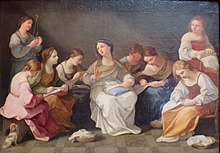Tundles
Tundeln is a historical braiding technique that was used to create cords , ribbons or cords . There were z. B. decorative ribbons for certificates , bags or hats made.
The ends of four threads (colored as differently as possible) are each tied to a so-called tundel wood , the other ends are knotted together. The knotted end must be attached so high that the tundels hang about at the level of the hands. Usually two people throw the tundles to each other in a certain order, which intertwines the threads and results in a certain color pattern; however, the technique can also be carried out alone. Additional thread can be wound onto the tundel wood, which is up to 20 cm long and shaped like large clappers , so that the resulting cord can be of any length.
history

A leather cord from the Bronze Age found in a bog in Denmark (the Krogens Mølle Mose) and an Iron Age cord from Finland could have been made using this technique. Up until recently, Scandinavian children used tundling as a game. A similar method was used in ancient Persia and Palestine , using stones instead of tundels.
In a painting by the Renaissance artist Guido Reni , the tundling can be seen in the background, with the ends of the threads hanging from a kind of skirt so that the technique can be practiced alone and while standing or sitting.
The so-called “barrel sash” from the 19th century in the Kulturhistorisches Museum Stralsund has tundled fringes.
In Japan, the Kumihimo exists as a comparable handicraft , which is carried out with the Marudai and the tama ( coils , comparable to the tundel wood) hanging on it.
literature
- Andrea Grillenberger: Tundeling - an old technique. Braided key chain. In: HTW practice. Housekeeping, textile work, works; Ideas for creative teaching . Vol. 54, No. 2, 2003, pp. 16-17. Prögel, Munich and Oldenbourg, ISSN 0940-7006 .
- Maria-Anna Roth-Kupka: “Tundling. Three-dimensional braiding. ”In: HTW practice. Housekeeping, textile work, works; Ideas for creative teaching . Vol. 49, No. 12, 1997, p. 352. Prögel, Munich and Oldenbourg, ISSN 0940-7006 .
Web links
- Explanations about "Whipcording" as Nordic textile art (English)
- Explanations and instructions in English (PDF file; 150 kB)
- Simple instructions in English with drawings (PDF file; 54 kB)
- Numerous photos and a video from Tundelvorgang (English)
Individual evidence
- ↑ Ernst Kallmann: Weaving. Introduction to hand weaving techniques . 2nd edition, Maier Verl., Ravensburg 1950 (chapter Tundled cords , p. 72), scan of the 1st edition with chapter Tundeln on pp. 68-69 (PDF file; 3.58 MB).
- ^ Margrethe Hald: Ancient Danish Textiles from Bogs and Burials . National Museum of Denmark, Copenhagen 1980, ISBN 87-480-0312-3 . Pp. 237-240.
- ↑ Hildegund Hergenhan: Upschöttels. Band in Pomerania - remains and traces. Selbstverl., Kiel 2003, pp. 58–59 u. Pp. 129-130.